Dallas (214) 340-8885
Athens (903) 677-9090
Gun Barrel City (903) 887-4341
Dallas (214) 340-8885
Athens (903) 677-9090
Gun Barrel City (903) 887-4341
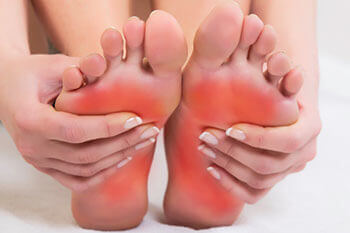 The feet, being the foundation of the body, carry all of the body’s weight and are therefore prone to experiencing pain and discomfort. If you are experiencing foot pain, it is important to determine where in the foot you are experiencing this pain to help discover the cause of it. While pain can be experienced virtually anywhere in the foot, the most common sites of foot pain are in the heel and ankle.
The feet, being the foundation of the body, carry all of the body’s weight and are therefore prone to experiencing pain and discomfort. If you are experiencing foot pain, it is important to determine where in the foot you are experiencing this pain to help discover the cause of it. While pain can be experienced virtually anywhere in the foot, the most common sites of foot pain are in the heel and ankle.
Heel pain can be due to a multitude of conditions including plantar fasciitis, Achilles tendinitis, and heel spurs. Pain experienced in the ankle can be a sign of an ankle sprain, arthritis, gout, ankle instability, ankle fracture, or nerve compression. In more serious cases, pain the foot can be a sign of improper alignment or an infection.
Foot pain can be accompanied by symptoms including redness, swelling, stiffness and warmth in the affected area. Whether the pain can be described as sharp or dull depends on the foot condition behind it. It is important to visit your local podiatrist if your foot pain and its accompanying symptoms persist and do not improve over time.
Depending on the location and condition of your foot pain, your podiatrist may prescribe certain treatments. These treatments can include but are not limited to prescription or over-the-counter drugs and medications, certain medications, cortisone injections, or surgery.
If you are experiencing persistent foot pain, it is important to consult with your foot and ankle doctor to determine the cause and location. He or she will then prescribe the best treatment for you. While milder cases of foot pain may respond well to rest and at-home treatments, more serious cases may take some time to fully recover.
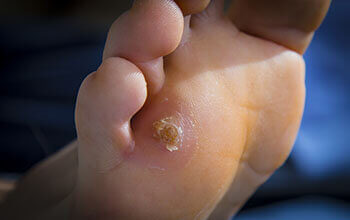 Corns are thickened areas on the skin’s surface, to the point of being irritating and sometimes painful. Commonly found on the feet, corns are circular or cone-shaped and develop where there are areas of pressure or friction, such as on the little toe when it rubs up against shoes or on the ball of your foot.
Corns are thickened areas on the skin’s surface, to the point of being irritating and sometimes painful. Commonly found on the feet, corns are circular or cone-shaped and develop where there are areas of pressure or friction, such as on the little toe when it rubs up against shoes or on the ball of your foot.
Corns are often confused with a callus, but there is a difference between them. Corns can be raised bumps that are painful to the touch. They consist of a rough, thick area of skin that may be dry or waxy. Corns tend to be surrounded by skin that is inflamed, and are usually much smaller than calluses.
The best treatment for a corn varies from person to person and is best determined by a podiatrist. Certain topical over-the-counter products may be suggested, or a more serious treatment may be prescribed. Diabetics should consult with a podiatrist immediately if they have developed a corn, as small wounds such as corns can develop into more serious conditions.
Orthotic inserts, which are fitted by a podiatrist, may also help with treating corns. Inserts fit right into the shoes and adjust the way the feet fit into the shoes, thus fixing the way one walks. Proper-fitting orthotics can help reduce friction, which can in turn help reduce corn formation and exacerbation.
Surgery is rarely used to treat corns, but does occur on occasion. Corn surgery actually deals with the underlying issue that causes corns. During surgery, the bone is shaved and any abnormalities are corrected, thus reducing the amount of friction that occurs during walking.
To prevent corns, the first step is reducing friction. Always wear shoes that fit well and don’t rub the feet. Wearing cushioned insoles in your shoes can also reduce friction. While there are many ways to prevent corns, it is best to consult a podiatrist with any questions you may have.
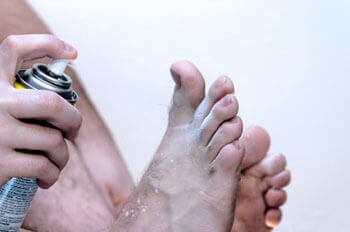 Athlete’s foot is an extremely contagious infection caused by a fungus that results in itching, burning, dry, and flaking feet. The fungus that causes Athlete’s foot is known as tinea pedis and thrives in moist, dark areas such as shower floors, gyms, socks and shoes, commons areas, public changing areas, bathrooms, dormitory style houses, locker rooms, and public swimming pools. Athlete’s foot is difficult to treat as well because of the highly contagious and recurrent nature of the fungus.
Athlete’s foot is an extremely contagious infection caused by a fungus that results in itching, burning, dry, and flaking feet. The fungus that causes Athlete’s foot is known as tinea pedis and thrives in moist, dark areas such as shower floors, gyms, socks and shoes, commons areas, public changing areas, bathrooms, dormitory style houses, locker rooms, and public swimming pools. Athlete’s foot is difficult to treat as well because of the highly contagious and recurrent nature of the fungus.
Athlete’s foot is spread by direct contact with an infected body part, contaminated clothing, or by touching other objects and body parts that have been exposed to the fungus. Because the feet are an ideal place for tinea to grow, thrive, and spread, this is the most commonly affected area, but it is known to grow in other areas.
The most commonly infected body parts are the hands, groin, and scalp, as well as obviously the feet. Around 70% of the population suffer from tinea infections at some point in their lives, however not all of these cases are Athlete’s foot. Just like any other ailment, some people are more likely to get it than others; such as people with a history of tinea infections or other skin infections, both recurring and non-recurring ones. On top of this, the extent to which a person experiences regrowth and recurrent tinea infections varies from person to person.
Sometimes people will not even know that have Athlete’s foot because of a lack of symptoms. However, most people experience mild to moderate flaking, itching, redness, and burning. Some of the more severe symptoms include cracking and bleeding skin, intense itching and burning, pain while walking or standing, and even blistering.
Because of the recurring nature of tinea fungus and the Athlete’s foot it causes, the best way to treat this condition is with prevention. While it is hard to completely avoid, you can take some preventative measures such as wearing flip flops or sandals in locker rooms and public showers to reduce contact with the floor. It is important to keep the feet clean and dry, which will allow them to air out and breathe. If you suspect you have Athlete’s foot, immediately visit your local podiatrist to determine what treatment is best for you.
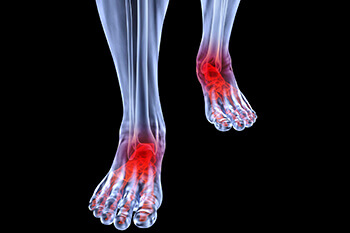 During your lifetime, you will probably walk about 75,000 miles, which is quite a lot of stress to put on your feet. As you get older, the 26 bones and 30 joints in your body will lose flexibility and elasticity, and your foot’s natural shock absorbers will wear down too. Having arthritis in addition to life’s wear and tear only makes matters worse; the joints will become distorted and inflamed, making arthritic foot care an important thing to consider for your overall health.
During your lifetime, you will probably walk about 75,000 miles, which is quite a lot of stress to put on your feet. As you get older, the 26 bones and 30 joints in your body will lose flexibility and elasticity, and your foot’s natural shock absorbers will wear down too. Having arthritis in addition to life’s wear and tear only makes matters worse; the joints will become distorted and inflamed, making arthritic foot care an important thing to consider for your overall health.
When dealing with arthritis, having additional foot complications—such as bunions, hammertoes, or neuromas—may be a serious detriment. To avoid these, buying well-fitting shoes with a lower heel and good support is a must. Having shoes with good arch support is highly recommended.
Aside from getting good arch support, the shoes need to fit comfortably and properly as well. A good place to start is by leaving a finger width between the back of the shoe and your foot to gauge proper size. It is also helpful to have a square or rounded toe box in the front to provide even more comfort. Another thing to look for is a rubber sole that can provide a cushion and absorb shock as you walk. This adds flexibility to the ball of your foot when you push off your heel to walk.
Exercise is another key aspect of arthritic foot care, as it not only strengthens and stretches the muscles and joints but helps prevent further injury and pain as well. Certain non-steroid, non-inflammatory drugs or topical medicines may be recommended by your podiatrist to help ease arthritic pain. Be sure to visit your podiatrist to determine what method of care is best for you.
 Pain experienced in the ankle can be caused by a multitude of conditions. While the most common cause is an ankle sprain, other possible problems can include arthritis, gout, ankle instability, ankle fracture, nerve compression, or tendinitis. In more serious cases, ankle pain can be a sign of improper alignment of the foot or an infection.
Pain experienced in the ankle can be caused by a multitude of conditions. While the most common cause is an ankle sprain, other possible problems can include arthritis, gout, ankle instability, ankle fracture, nerve compression, or tendinitis. In more serious cases, ankle pain can be a sign of improper alignment of the foot or an infection.
Ankle pain can often be accompanied by symptoms such as redness, swelling, stiffness and warm in the affected area. Pain can be described differently depending on the condition; short, stabbing pain and a dull ache are some examples. If such symptoms are persistent and do not improve after time, be sure to schedule an appointment with your local podiatrist.
Depending on the condition behind your ankle pain, different treatments may be prescribed by your podiatrist. For ankle sprains, the first step in treatment involves rest, ice, elevation, and compression. Be sure to avoid placing pressure on the ankle, use an ice pack several times a day, and use a compression bandage and elevation to reduce swelling. Other more serious conditions may require the assistance of certain drugs and medications such as nonsteroidal anti-inflammatory drugs (NSAIDs), physical therapy, or even cortisone injections.
Consult with your foot and ankle doctor to best determine the cause of your ankle pain and the appropriate treatment. Depending on the severity of your ankle pain and the condition behind it, recovery from ankle pain may take some time.
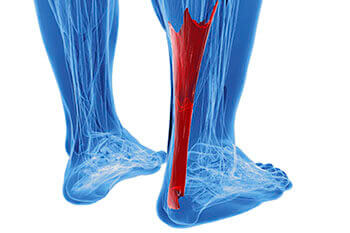 The Achilles tendon is the strongest tendon in the human body. Its purpose is to connect the lower leg muscles and calf to the heel of the foot. This tendon is responsible for facilitating all types of movement, like walking and running. Since this tendon provides an enormous amount of mobility to an individual, any injuries inflicted to this tissue should be immediately brought up with a physician to prevent further damage.
The Achilles tendon is the strongest tendon in the human body. Its purpose is to connect the lower leg muscles and calf to the heel of the foot. This tendon is responsible for facilitating all types of movement, like walking and running. Since this tendon provides an enormous amount of mobility to an individual, any injuries inflicted to this tissue should be immediately brought up with a physician to prevent further damage.
The most common injuries that can trouble the Achilles tendon are tendon ruptures and Achilles tendinitis. Achilles tendinitis is the milder of the two injuries and can be recognized by the following symptoms: inflammation, dull to severe pain, an increased flow of blood to the tendon, thickening of the tendon, and slower movement time. Tendinitis can be treated via several methods and is often diagnosed by an MRI.
An Achilles tendon rupture is trickier to heal, and is by far the most painful injury. It is caused by the tendon ripping or completely snapping. The results are immediate and absolutely devastating, and will render the patient immobile. If a rupture or tear occurs, operative and non-operative methods are available. Once the treatment begins, depending on the severity of the injury, recovery time for these types of issues can take up to a year.
Simple preventative measures can be taken as a means to avoid both injuries. Prior to any movement, taking a few minutes to stretch out the tendon is a great way to stimulate the tissue. Calf raises, squats, leg curls, leg extensions, leg raises, lunges, and leg presses are all suggested ways to help strengthen the lower legs and promote Achilles tendon health.
Many problems arise among athletes and people who overexert themselves while exercising or who do not properly warm up before beginning an activity. Proper, comfortable shoes that fit correctly can also decrease tendon injuries. Some professionals also suggest that when exercising, you should make sure that the floor you are on is cushioned or has a mat, as this will relieve pressure on the heels. As always, a healthy diet will also increase tendon health.
It is very important to seek out a podiatrist if you believe you have an injury in the Achilles region, because further damage could result in severe complications that would make being mobile difficult, if not impossible.
Willie Cauley-Stein was one of this year’s big winners in the NBA draft when the Sacramento Kings chose him as the 6th overall draft. His teammate over at the University of Kentucky, Karl Anthony Towns was first on the list after being picked by the Minnesota Timberwolves.
The former Kentucky big man suffered a stress fracture from a previous game against Louisville. The injury left the Wildcat center sidelined for the rest of the season. This is exactly what many analysts downplayed Willie Cauley-Stein’s draft standings even placing him outside the top ten picks.
Big men with histories of foot injuries are a special concern among NBA teams. Previous promising draft picks who landed at the top spot who later suffered season ending injuries left teams with multi-million contract players sitting at the sidelines.
Willie Cauley-Stein described his injury as a stress fracture or cracked bone. He underwent surgery to treat the condition and did not come back to Kentucky for the remainder of the season. Nagging questions include concerns if the foot was able to heal properly or whether this could lead to chronic foot injuries.
Big ticket athletes involved in high risk activities are prone to stress fractures. But foot injuries are common even for non-athletes. Pain and tenderness in the feet can be early indication of a foot injury. Consult a podiatrist if you notice any of these symptoms.
Dr. Jonathan Kletz is a podiatrist who specializes in helping people suffering from foot injuries.
Risk Factors for Stress Fractures:
Stress fractures could be prevented by avoiding strenuous activities before your feet are ready. Warm-ups or gradually increasing foot strength is recommended before engaging in any type of sport.
Texas Foot Works located in Dallas, Athens and Gun Barrell City, TX, we specialize in helping people suffering from foot injuries. To schedule an appointment, call 214-340-8885.
The talus is a very important structure in the ankle. It is essential for the ankle’s normal movement. A talus fracture can occur during a broken ankle injury. A talus injury usually happens as a result of a vehicular accident or high impact falls.
Consult a podiatrist if you notice any of these symptoms to ensure proper diagnosis of the foot injury.
A podiatrist can recommend several test to positively identify a talus fracture. This includes x-rays and other imaging procedures to rule out injuries and to identify the extent of an injury. Dr. Jonathan Kletz is a podiatrist who specializes in helping people with Talus fractures.
A podiatrist conducts a physical examination to visually assess the extent of foot injury. A podiatrist assesses blood circulation to ensure maximum blood flow to the injured area for faster healing. The podiatrist will also examine toe sensation to assess for any nerve damage.
Physical examinations can also include a check for possible compartment syndrome. This is caused by the buildup of pressure in the feet due to fluids. A podiatrist can also check any cuts or wounds resulting from the fracture.
For more accurate diagnosis, imaging tests are performed. This will also help the podiatrist in developing a more targeted approach to treatment. It will help them identify if a surgical procedure is required for correcting the injury.
X-rays provide an inexpensive option for positively checking the presence of a talus fracture. It can show the bones affected and if these have been dislocated or broken. A CT scan or Computed Tomography scan on the other hand, produces a more detailed look into the talus fracture. It not only shows bone images but also gives a detailed look into surrounding tissues and ligaments.
Texas Foot Works located in Dallas, Athens and Gun Barrell City, TX, we specialize in helping people with Talus fractures. To schedule an appointment, call 214-340-8885.
Therapeutic shoes have gone a long way in terms of design that these could pass as regular shoes without people noticing that you are wearing them. If you’re a diabetic or suffering from a foot condition, therapeutic shoes are a must for preventing diabetic foot conditions or preventing it from developing.
Benefits of Therapeutic Footwear
Better foot support
Inserts could be used to restore normal foot structure to those with flat foot or high arches. The feet are responsible for supporting our weight. Any abnormalities in our foot structure leaves us at high risk for injury. A flat foot or high arch can lead to foot injury because it places huge stresses on certain bones or joints in the feet.
Pain management
Therapeutic shoes give people suffering a welcome relief from foot pain and discomfort. People with hammertoes for example would benefit from a wider toe box. These shoes are also made from more comfortable materials that are less confining. A visit to your podiatrist could help you identify possible footwear solutions to your foot problems.
Dr. Jonathan Kletz is a podiatrist who specializes in helping people with foot disorders and injuries.
Improved blood flow
High levels of blood sugar can interfere with normal circulation especially in the feet. Diabetics have a high risk of developing neuropathy or diminished sensation on their feet. This makes it harder for them to notice cuts or blisters that can lead to serious infection. Without the normal supply of blood in the feet, the immune system becomes inefficient in providing defense against infection. Healing is also compromised due to the lack of nutrients reaching the feet.
Better mobility
Wearing therapeutic shoes makes moving much easier. Pain and discomfort make simple movements such as walking difficult. With therapeutic shoes people suffering from foot conditions such as hammertoes and other foot deformities move more freely because it reduces pain and discomfort.
It is cheaper compared to surgery
Therapeutic shoes are definitely cheaper compared to foot surgery. But this is not designed to replace surgical treatments for foot deformities but can only be used to prevent serious foot complications that require foot surgery.
Texas Foot Works located in Dallas, Athens and Gun Barrell City, TX, we specialize in helping people with foot conditions. To schedule an appointment, call 214-340-8885.
Our toenails may not get the same attention as other foot structures. This is why many cases of toenail disorders have significantly progressed before it is brought to the attention of a podiatrist. A common toenail condition is onychomycosis or a fungal nail infection. Symptoms include a yellowish discoloration of the toenails accompanied with thickened nails. While a fungal nail is easy to identify, other toenail conditions exist. Below is a list of toenail conditions and causes.
Senile nails – this condition usually comes with aging. As we grow old nails become brittle and ridges develop. You can minimize the formation of ridges by not soaking your toenails for long periods of time.
Red/ black nails – this can be dry blood on the nail bed resulting from injury or trauma. However, this is pushed out as the toenail grows. For those with black and red nails that doesn’t go away or move from its location then it is advised that you consult a podiatrist.
Dr. Jonathan Kletz is a podiatrist who specializes in helping people with toenail conditions and disorders.
Lines and ridges – this can be caused by hormonal changes are is often seen in pregnancy. A ridge at the center of the nail can be caused by nail bites.
Green Nails – a greenish tint on your nails can be an indication of a bacterial infection. Treatment can be done by trimming the nail short every week. This could take anywhere up to three months. Avoid soaking the nails and dry the nails thoroughly after bathing. Anti-bacterial medications are also available.
Pitted Nails – is a nail bed condition that can be caused by skin disorders such as psoriasis. It can leave a tannish color and could be seen at the area of nail growth.
Chronic Nail Trauma – repeated nail injury due to sports or accidents. It can lead to toenail deformities. This can also be caused by wearing tight-fitting foot wear.
Redness of the skin around the nail – inflammation at the bottom of the nail can be caused by a bacterial infection. It can create skin opening which other infections such as fungus can take advantage of. Creams are available for treating this condition.
Yellowish nails - a tell-tail sign of a fungal infection. The yellowish discoloration is air located below the nail. Regular trimming for two to three months can cure the condition.
A change in skin color can also indicate other skin problems such as skin cancer. If symptoms don’t go away after treatment, then a visit to a podiatrist can help you identify if these are caused by common toenail conditions or an underlying disease.
Texas Foot Works located in Dallas, Athens and Gun Barrell City, TX, we specialize in helping people with toenail conditions. To schedule an appointment, call 214-340-8885.